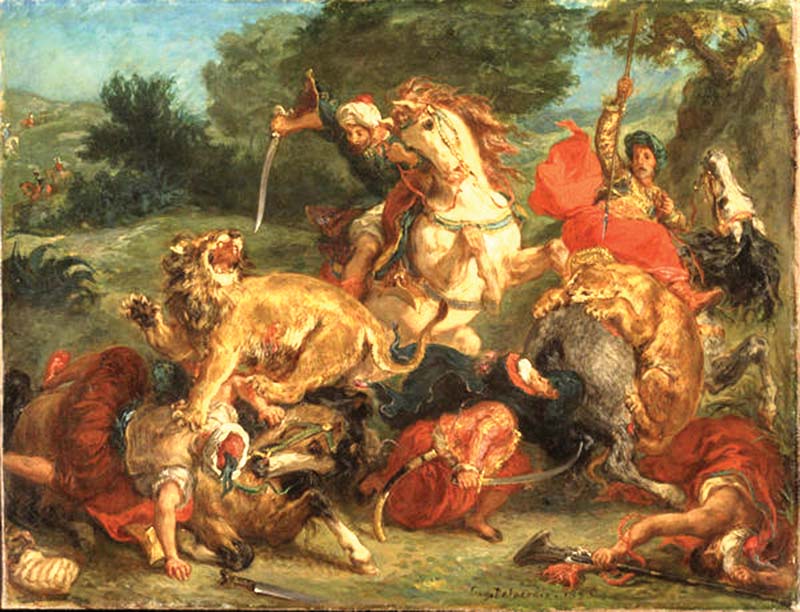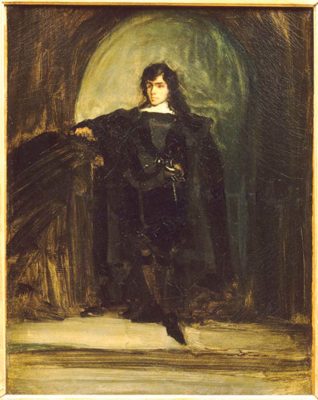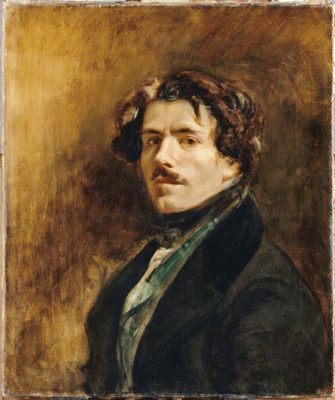
Ferdinand Victor Eugène Delacroix (1798–1863) was a French Romantic artist, regarded as the leader of the French Romantic school and one of the greatest creative figures of the 19th century. Through his choice of daring compositions, a colorful palette, and bold brushwork, he set into motion a cascade of innovations that changed the course of art. The Metropolitan Museum of Art presents Delacroix, the first comprehensive retrospective in North America devoted to the artist. It is also the first time many of his works will be on display here. The exhibition encompasses 12 galleries and will provide an overview of the three main phases of Delacroix’s four-decade career. From his formative years dominated by a thirst for fame and freedom (1822-1834), and his exploration of historical themes (1835-1855), to the third and final phase, which follows Delacroix’s growing interest in nature and the creative role of memory, up until his death in 1863.
As Vincent Van Gogh wrote in 1885: “What I find so fine about Delacroix is precisely that he reveals the liveliness of things, and the expression and the movement that he is utterly beyond the paint.”
This historic exhibition will illuminate Delacroix’s restless imagination in all its complexity through more than 150 paintings, drawings, prints, and manuscripts—many of which have never been shown before in the United States. In addition to works from The Met collection, the exhibition will include exceptional loans from the Musée du Louvre and some 60 museums and private collections throughout Europe and North America. Among the highlights are Delacroix’s landmark works Greece on the Ruins of Missolonghi (1826), The Battle of Nancy (1831), Women of Algiers in Their Apartment (1834), Medea About to Kill Her Children (1838) and The Lion Hunt (1855).
“Delacroix was a transformative figure in the history of European painting, and his influence significantly shaped what we think of today as modern,” said Max Hollein, director of The Metropolitan Museum of Art. “This exhibition is a rare opportunity to experience the breathtaking talent and remarkable scope of one of the most creative forces of the nineteenth century.”
Visitors to the exhibition will be confronted by two monumental canvases representing the poles of Delacroix’s imagination: an allegory of war, Greece on the Ruins of Missolonghi (1826), and a Biblical subject, Christ in the Garden of Olives (1824–26). Having defined the scale of Delacroix’s ambition through large paintings, the exhibition then introduces him through images of the artist emblematic of the Romantic era. This gallery will be centered on his self-portrait of about 1837. Born into a distinguished family but orphaned at age 16, Delacroix grew very close to friends and relatives, many of whom are featured in some of his most illuminating portraits.
For the first time ever in the United States, a representative selection of notebooks that made up Delacroix’s handwritten journal will be displayed, on loan from the leading repository of the artist’s writings, the Institut National d’Histoire de l’Art, Paris. From schoolboy musings to mature reflections on the nature of beauty, these manuscripts reveal one of the great painter-writers in the history of art, particularly in accounts of his early career.
The presentation then moves to a close examination of Delacroix’s progressive mastery of materials in the 1820s—including oil paint, pencil, pen and ink, and watercolor—as he underwent formal artistic training under the prominent Neoclassical painter Pierre Narcisse Guérin. During this time, Delacroix had breakthroughs in rendering the textures and luminosity of human skin, as seen in Mademoiselle Rose (ca. 1820–23) and the multiracial model Aspasie (ca. 1824).
Delacroix had a lifelong fascination with animal physiognomy. In 1828, he studied animals at the menagerie in Paris’s Jardin des Plantes, an important center of scientific inquiry. The exhibition provides a nimble, intimate account of Delacroix’s approach to wild cats, horses and humans with a centerpiece of Young Tiger Playing with its Mother (1830), Delacroix’s masterwork in the genre.
In 1832, Delacroix accompanied a diplomatic mission to Morocco. Having never traveled to Italy to experience the remnants of classical antiquity firsthand, Delacroix was captivated by what he understood as the “living antiquity” he encountered in North Africa. He drew numerous portraits of the people he met, including the never-before-exhibited Jewish Woman of Tangier and Schmareck, Tanner at Tangier (both 1832). The Met’s exhibition of Street in Meknes (1832), Women of Algiers in Their Apartment (1834), and Collision of Arab Horsemen (1833/34) will be the first time that these three works will be shown together, as the artist intended.
From the 1840s onward, the artists embraced still lifes, floral compositions and scenes from Renaissance literature as evident in the seminal still life Basket of Flowers (1848–49), which underwent a yearlong treatment to remove a disfiguring layer of old varnish.
A major development in Delacroix’s later work was the increased role of landscape and seascape in his artistic vision, as seen in The Shipwreck of Don Juan (1840), The Sea at Dieppe (1852), and an ensemble of studies related to his final large-scale mural project, Jacob Wrestling the Angel (1850), at the Parisian church of Saint-Sulpice. The exhibition will conclude with The Lion Hunt (1855), which survives as a massive fragment after its upper section was destroyed in a fire in 1870. It Delacroix’s lifelong preoccupation with Rubens, Orientalist subjects, battles, and animals.
Delacroix is made possible by the Eugene V. and Clare E. Thaw Charitable Trust. The exhibition is organized by The Metropolitan Museum of Art and the Musée du Louvre, specifically Asher Miller, associate curator in the Department of European Paintings at The Met, in collaboration with Sébastien Allard, director of the Department of Paintings at the Musée du Louvre, and Côme Fabre, curator in the Department of Paintings at the Musée du Louvre.
The Delacroix exhibit is on display at The Met Fifth Avenue in the Tisch Galleries, Gallery 899 on the second floor through Jan. 6. For more information, visit www.metmuseum.org/exhibitions/listings/2018/delacroix.
—Additional information courtesy of the Metropolitan Museum of Art




















